| Revision as of 02:27, 4 April 2014 editEddaido (talk | contribs)Autopatrolled, Extended confirmed users21,430 edits Undid revision 602645751 by SamBlob (talk) So this is WAR then← Previous edit | Revision as of 10:59, 4 April 2014 edit undoSamBlob (talk | contribs)Autopatrolled, Pending changes reviewers9,789 edits Fine; keep the Tiger Moth. At least put in some structure so people aren't confused as to whether the Comet or the Tiger Moth was the first jet airliner.Next edit → | ||
| Line 22: | Line 22: | ||
| '''De Havilland Aircraft Company Limited''' {{IPAc-en|d|ə|ˈ|h|æ|v|ɨ|l|ən|d}} was a British aviation manufacturer established in late 1920 by ] at ] ] on the outskirts of London. Operations were later moved to ] in Hertfordshire. | '''De Havilland Aircraft Company Limited''' {{IPAc-en|d|ə|ˈ|h|æ|v|ɨ|l|ən|d}} was a British aviation manufacturer established in late 1920 by ] at ] ] on the outskirts of London. Operations were later moved to ] in Hertfordshire. | ||
| De Havilland Aircraft Company was responsible for producing the first ] |
De Havilland Aircraft Company was responsible for producing the ], the first ] aircraft. The company also made other notable aircraft, including the ] trainer. | ||
| In 1960 de Havilland became a member of the Hawker Siddeley group but lost its separate identity in 1963. Today it is part of ] the British aerospace and defence business. | In 1960 de Havilland became a member of the Hawker Siddeley group but lost its separate identity in 1963. Today it is part of ] the British aerospace and defence business. | ||
Revision as of 10:59, 4 April 2014
For other uses, see de Havilland (disambiguation).
| [REDACTED] | |
| Industry | Aerospace |
|---|---|
| Founded | 1920 |
| Defunct | 1964 |
| Fate | Incorporated into Hawker Siddeley |
| Headquarters | Hatfield, Hertfordshire, England |
| Key people | Geoffrey de Havilland, founder and aircraft designer |
| Products | Civil and military aircraft, aero-engines, guided weapons |
| Parent | Hawker Siddeley (from 1959) |
| Subsidiaries | De Havilland Canada (1928) De Havilland Australia (1927) Airspeed Ltd. (1940–1951) De Havilland Propellers (1935–1961) De Havilland Engine Company (1944–1961) |
De Havilland Aircraft Company Limited /dəˈhævlənd/ was a British aviation manufacturer established in late 1920 by Geoffrey de Havilland at Stag Lane Aerodrome Edgware on the outskirts of London. Operations were later moved to Hatfield in Hertfordshire.
De Havilland Aircraft Company was responsible for producing the DH 106 Comet, the first passenger jet aircraft. The company also made other notable aircraft, including the Tiger Moth trainer.
In 1960 de Havilland became a member of the Hawker Siddeley group but lost its separate identity in 1963. Today it is part of BAE Systems plc the British aerospace and defence business.
History
Geoffrey de Havilland's new enterprise came about because in January 1920 Airco, his employer (as technical director and chief designer), was shut down by BSA. BSA bought Airco on 20 January 1920 from Holt Thomas on the say-so of one director, Percy Martin, having made no "due diligence" enquiry. Within days BSA shut it down having discovered Airco's true circumstances. The losses because of this unwise investment were so grievous industrial giant BSA paid no dividend at all for four years.
With George Holt Thomas's help Geoffrey de Havilland took modest premises at the nearby Stag Lane Aerodrome and formed a limited liability company, De Havilland Aircraft Company Limited, incorporated 26 September 1920. The directors were Geoffrey de Havilland, Arthur E Turner and Charles C Walker. Nominal capital £50,000.
The real capital was from:
- Geoffrey de Havilland, £3,000
- George Holt Thomas, £10,000
- Others £1,000
Banking on an order worth about £2,500 originally intended for Airco he took with him friends: Charles Clement Walker (aerodynamics and stressing), Wilfred E Nixon (company secretary), Francis E N St Barbe (business and sales), and Frank Hearle (works manager). Hugh Burroughes went to Gloster Aircraft. The fledgling enterprise was lucky to be approached the next year by a man wanting a new aeroplane built for him, Alan Samuel Butler. He invested heavily in the business. The first year's turnover was £32,782 and net profit £2,387 and in early 1922 they bought Stag Lane aerodrome for £20,000. They survived until 1925 when de Havilland's own design, the Moth - first flown 22 February 1925 - proved to be just what the flying world was waiting for. In 1928 De Havilland Aircraft Company Limited went public.
Initially, De Havilland concentrated on single and two-seat biplanes, essentially continuing the DH line of aircraft built by Airco, but powered by de Havilland's own Gipsy engines. These included the Gipsy Moth and Tiger Moth. These aircraft set many aviation records, many piloted by de Havilland himself. Amy Johnson flew solo from England to Australia in a Gipsy Moth in 1930.
The Moth line of aeroplane continued with the more refined (and enclosed) Hornet Moth and Moth Minor, the latter being a low-wing monoplane constructed of wood. One of De Havilland's trademarks was that the name of the aircraft type was painted on using a particularly elegant Roman typeface, all in capital letters. When there was a strike at the plant, the artisans who painted the name on the planes used the same typeface to make the workers' protest signs.
The DH 84 Dragon was the first aeroplane purchased by Aer Lingus, who later operated the DH 86B Dragon Express and the DH 89 Dragon Rapide. De Havilland continued to produce high-performance aircraft including the twin-piston-engine DH 88 Comet racer, one of which became famous in its red livery as the winner of the MacRobertson Air Race from England to Australia in 1934.

The high-performance designs and wooden construction methods culminated in perhaps the most famous de Havilland aircraft—the Mosquito, constructed primarily of wood because of the shortage of aluminium during the Second World War. The company followed this with the even higher-performing Hornet, which was one of the pioneers of the use of metal-wood and metal-metal bonding techniques.
After the Second World War, De Havilland continued with leading-edge designs in both the military and civil field, but several public disasters doomed the company as an independent entity. The experimental, tailless, jet-powered de Havilland DH 108 Swallow crashed in the Thames Estuary, killing Geoffrey de Havilland Jr, son of the company's founder. A large additional aircraft factory was acquired in 1948 at Hawarden Airport at Broughton near Chester where production supplemented the Hatfield output. The De Havilland Comet was put into service in 1952 as the eagerly-anticipated first commercial jet airliner, twice as fast as previous alternatives and a source of British national pride. The Comet suffered three tragic and high-profile crashes in two years. Less well remembered, but equally disastrous, was the in-flight break up of the DH 110 prototype during the 1952 Farnborough Airshow, which also killed members of the public.
Following the structural problems of the aircraft in 1954, all remaining Comets were withdrawn from service, with de Havilland launching a major effort to build a new version that would be both larger and stronger. This one, the Comet 4, enabled the De Havilland airliner to return to the skies in 1958. By then, the United States had its Boeing 707 jetliner along with the Douglas DC-8, both of which were faster and more economical to operate. Orders for the Comet dried up.
Hawker Siddeley bought De Havilland in 1960 but kept it as a separate company until 1963. In that year it became the de Havilland Division of Hawker Siddeley Aviation and all types in production or development changed their designations from "DH' to "HS" (see Hawker Siddeley Trident and BAe 125). The famous "DH" and the de Havilland name live on, with several hundred Moths of various types and substantial numbers of many of the company's other designs still flying all over the world.
De Havilland returned to the airline world in 1962 with a three-engine jetliner, the DH 121 Trident. However, the design was modified to be smaller to fit the needs of one airline and one man: MRAF Sholto Douglas later Lord Douglas of Kirtleside, chairman of British European Airways. Other airlines found it unattractive and turned to a rival tri-jet: the Boeing 727 which was much the same size as the original DH 121. De Havilland built only 117 Tridents, while Boeing went on to sell over 1,800 727s.
De Havilland also pushed into the new field of long-range missiles, developing the liquid-fuelled Blue Streak. It did not enter military service but became the first stage of Europa, a launch vehicle for use in space flight. In flight tests, the Blue Streak performed well—but the upper stages, built in France and Germany, repeatedly failed. In 1973, the Europa programme was cancelled, with Blue Streak dying as well. The last of them wound up in the hands of a farmer who used its fuel tanks to house his chickens.
Products
Aircraft

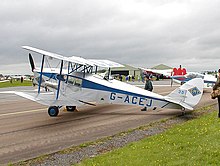
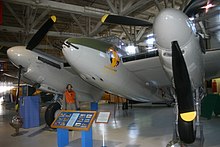

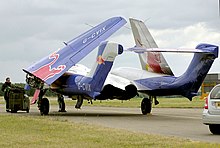

- Biplanes
- De Havilland Biplane No. 1
- De Havilland Biplane No. 2
- Airco DH.1 2 seat pusher scout
- Airco DH.2 pusher scout
- Airco DH.3 twin engine bomber
- Airco DH.4 single engine bomber
- Airco DH.4A transport
- Airco DH.5 scout
- Airco DH.6 trainer
- Airco DH.9 single engine bomber
- Airco DH.9A - Westland development of the DH.9 with Liberty engine
- Airco DH.9C transport
- Airco DH.9J trainer
- Airco DH.10 Amiens twin engine bomber
- DH.11 Oxford long range twin engine day bomber
- DH.12
- DH.14 Okapi single engine bomber
- DH.15 Gazelle experimental flying test bed
- DH.16 4 passenger airliner similar to DH.9C
- DH.18 8 passenger airliner
- DH.27 Derby single engine long range day bomber
- DH.34
- DH.37
- DH.42 Dormouse
- DH.42A & B Dingo
- DH.48 Special re-engined DH.9
- DH.50 Giant Moth
- DH.51
- DH.54 Highclere
- DH.56 Hyena
- DH.60 Moth, Cirrus Moth, Genet Moth, Gypsy Moth
- DH.60G III Moth Major
- DH.61 Giant Moth
- DH.65 Hound
- DH.66 Hercules
- DH.67
- DH.72 Canberra
- DH.82 Tiger Moth biplane trainer
- DH.83 Fox Moth
- DH.84 Dragon
- DH.86 Express
- DH.87 Hornet Moth
- DH.89 Dragon Rapide
- DH.90 Dragonfly
- DH.92 Dolphin
- Glider
- Piston-engined monoplanes
- DH.29 Doncaster 10 passenger airliner
- DH.53 Humming Bird ultralight monoplane
- DH.71 Tiger Moth racer
- DH.75 Hawk Moth
- DH.77 lightweight fighter
- DH.80 Puss Moth
- DH.81 Swallow Moth
- DH.85 Leopard Moth
- DH.88 Comet racer
- DH.91 Albatross 4 engined airliner
- DH.93 Don
- DH.94 Moth Minor monoplane trainer
- DH.95 Flamingo twin-engined airliner
- DH.98 Mosquito & Sea Mosquito A highly successful wooden fighter-bomber of WWII
- DH.103 Hornet & Sea Hornet twin-engined fighter
- DH.104 Dove & Devon twin-engined airliner
- DH.114 Heron 4 engined airliner
- Civil and military jet transports
- DH.106 Comet
- DH.121 Trident later the HS Trident
- DH.125 later the HS.125
- DH.146 later the BAe.146
- Military jets
- Experimental aircraft
- DH.108 Swallow (1946)
- Autogyro
Spares
- Hardware
- DHS Bolts
- DHS Rivets
Weapon systems
- Missiles
- Firestreak air-to-air missile
- Bluestreak ballistic missile
- Spacecraft
Subsidiaries
De Havilland South Africa
De Havilland Canada

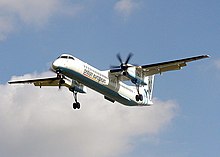
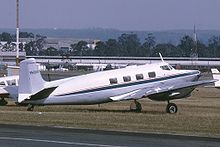
De Havilland Canada Aircraft of Canada Ltd. was formed in 1928 to build Moth aircraft for the training of Canadian airmen and continued after the war to build its own designs suited to the harsh Canadian environment. The DHC-2 to DHC-7 aircraft were all STOL designs. DHC spent a stint as a Canadian Crown Corporation, then as a subsidiary of Boeing, then back as a Crown Corporation. De Havilland (Canada) was eventually incorporated into the Bombardier group of companies and the Dash Eight remains in production with a particular emphasis being placed on its quiet operation in comparison to other aircraft of a similar size. In May 2005, Bombardier sold the rights to the out-of-production aircraft (DHC-1 through DHC-7) to Viking Air Ltd. of Sidney, British Columbia.
De Havilland Australia
Main article: de Havilland AustraliaThe first overseas subsidiary was set up in Australia in March 1927 as de Havilland Aircraft Pty. Ltd. The company moved from Melbourne to Sydney during 1930 where it acted as an agency for the parent company, with assembly, repair and spares facilities for the company's popular sporting and airliner types. Aircraft design and full manufacture by de Havilland Australia (DHA) did not take place until the Second World War, when the company began production of the DH 82 Tiger Moth primary trainer at Bankstown, NSW.
During the Second World War, DHA designed a small troop-carrying glider to be used if Australia was invaded by Japan. The DH-G1 emerged in mid-1942 and utilised the DH 84 Dragon forward fuselage, 87 of which were in production at the same factory as navigational trainers. The two built served as prototypes for the definitive DH-G2 produced the following year but the need had passed by this time and only six DH-G2s were built. The company also began to manufacture the Mosquito, with deliveries to the RAAF being first made in 1944. A total of 212 Mosquitos were built at Bankstown between 1943 and 1948. Some of these aircraft continued in RAAF service until 1953.
Licenced production of the De Havilland Vampire began in 1948, with the first of 190 built flying in 1949.
Another DHA design, the De Havilland Australia DHA-3 Drover, was manufactured between 1948 and 1953. Only 20 were produced, mostly for the Royal Flying Doctor Service (RFDS), Trans Australia Airlines and Qantas. The DHA-3 Drover was a 3-engined light transport derived from the DH 104 Dove, capable of carrying six-eight passengers. It was designed as a replacement for the DH 84 Dragon, which was common in Australia due to its wartime production by DHA. The engine chosen for the new design was the de Havilland Gipsy Major Mk-10 4s. Several Drovers were later re-engined with more powerful Lycoming O-360 horizontally-opposed engines to improve performance.
In 1959 a boat building division known as De Havilland Marine was established at the Bankstown factory.
The De Havilland Australia concern is now owned by Boeing Australia and is known as Hawker De Havilland Aerospace. On 6 Feb. 2009, Boeing announced that Hawker de Havilland changes its name to Boeing Aerostructures Australia.
- DH-G1
- DHA-G2
- DHA-3 Drover
De Havilland engines
Main article: de Havilland Engine CompanyAs well as a prolific aircraft builder, De Havilland was also a significant producer of aero engines. This went against usual practice- usually engines are designed and produced by a dedicated company though in the UK the Bristol Aeroplane Company had a substantial engine business and Armstrong Whitworth Aircraft was part of the same business as Armstrong Siddeley The successful "Gipsy" and the later developments such as the Gipsy Major were successful and popular power units, being used in nearly all of De Havilland's light designs and several aircraft from other manufacturers. Gipsy engines were relatively unusual by the 1930s/40s because they were in-line engines, at a time when radial or opposed-action engine layouts were more popular. The De Havilland company was also a competitor to Rolls-Royce and Metrovick in the early years of the jet engine development. Employing the services of Frank Halford then buying out his company they produced the de Havilland Goblin and De Havilland Ghost engines for first their jet fighters then the Comet.
Key people
Aircraft designers and engineers
Test pilots
- John Cunningham (RAF officer)
- Geoffrey de Havilland, Jr.
- John de Havilland (pilot)
- Campbell MacKenzie-Richards
- Hubert Broad
- Bert Hinkler
- Pat Fillingham
See also
References
Notes
- Davenport-Hines, R. P. T. Dudley Docker: The Life and Times of a Trade Warrior. Cambridge University Press 2002. ISBN 0-521-89400-X
- page 1070, Flight Magazine, 7 October 1920
- ^ RAF Museum website The De Havilland Aircraft Company Access date: 3 April 2014
- ^ page 254, Flight Magazine, 20 September 1940
- ^ Obituary, Sir Geoffrey de Havilland, O.M. The Times, Saturday, May 22, 1965; pg. 10; Issue 56328
- page 255, Flight Magazine, 20 September 1940
- RAF Museum website de Havilland History page Access date: 12 August 2007
- Landings.com Australia, Canada, New Zealand, UK & US Civil Aircraft Register databases. Access date: 12 August 2007
- de Havilland propellers
- "Sea Vixen: G-CVIX." airliners.net. Retrieved: 8 August 2010.
- GlobalSecurity.org
- After 1935, both part of the Hawker group.
Bibliography
- Bain, Gordon. De Havilland: A Pictorial Tribute. London: AirLife, 1992. ISBN 1-85648-243-X.
- Bransom, Alan. The Tiger Moth Story, Fifth Edition. Manchester, UK: Crécy Publishing Ltd., 2005. ISBN 0-85979-103-3.
- Hotson, Fred. The De Havilland Canada Story. Toronto: CANAV Books, 1983. ISBN 0-9690703-2-2.
- Jackson, A J. De Havilland Aircraft since 1909. Putnam, 1987. ISBN 0-85177-802-X
External links
- De Havilland Aviation Ltd – Restoring and preserving de Havilland, and other, jets
- de Havilland Aircraft Heritage Centre
- History of de Havilland
- The de Havilland Comet, the first commercial airliner
- de Havilland Aeronautical Technical School Association
| Timeline of British aerospace companies since 1955 | |||||||||||||||||||||||||||||||||||||||||||||||||||||||||||||||||||||||||||||||||||||||||||||||||||||||||||||||||||||||||||||||||||||||||||||||||||||||||||||||||||||||||||||||||||||||||||||||||||||||||||||||||||||||||||||||||||||||||||||||||||||||||||||||||||||||||||||||||||||||||||||||||||||||||||||||||||||||||||||||||||||||||||||||||||||||||||||||||||||||||||||||||||||||||||||||||||||||||||||||||||||||||||||||||||||||||||||||||||||||||||||||||||||||||||||||||||||||||||||||||||||||||||||||||||||||||||||||||||||||
|---|---|---|---|---|---|---|---|---|---|---|---|---|---|---|---|---|---|---|---|---|---|---|---|---|---|---|---|---|---|---|---|---|---|---|---|---|---|---|---|---|---|---|---|---|---|---|---|---|---|---|---|---|---|---|---|---|---|---|---|---|---|---|---|---|---|---|---|---|---|---|---|---|---|---|---|---|---|---|---|---|---|---|---|---|---|---|---|---|---|---|---|---|---|---|---|---|---|---|---|---|---|---|---|---|---|---|---|---|---|---|---|---|---|---|---|---|---|---|---|---|---|---|---|---|---|---|---|---|---|---|---|---|---|---|---|---|---|---|---|---|---|---|---|---|---|---|---|---|---|---|---|---|---|---|---|---|---|---|---|---|---|---|---|---|---|---|---|---|---|---|---|---|---|---|---|---|---|---|---|---|---|---|---|---|---|---|---|---|---|---|---|---|---|---|---|---|---|---|---|---|---|---|---|---|---|---|---|---|---|---|---|---|---|---|---|---|---|---|---|---|---|---|---|---|---|---|---|---|---|---|---|---|---|---|---|---|---|---|---|---|---|---|---|---|---|---|---|---|---|---|---|---|---|---|---|---|---|---|---|---|---|---|---|---|---|---|---|---|---|---|---|---|---|---|---|---|---|---|---|---|---|---|---|---|---|---|---|---|---|---|---|---|---|---|---|---|---|---|---|---|---|---|---|---|---|---|---|---|---|---|---|---|---|---|---|---|---|---|---|---|---|---|---|---|---|---|---|---|---|---|---|---|---|---|---|---|---|---|---|---|---|---|---|---|---|---|---|---|---|---|---|---|---|---|---|---|---|---|---|---|---|---|---|---|---|---|---|---|---|---|---|---|---|---|---|---|---|---|---|---|---|---|---|---|---|---|---|---|---|---|---|---|---|---|---|---|---|---|---|---|---|---|---|---|---|---|---|---|---|---|---|---|---|---|---|---|---|---|---|---|---|---|---|---|---|---|---|---|---|---|---|---|---|---|---|---|---|---|---|---|---|---|---|---|---|---|---|---|---|---|---|---|---|---|---|---|---|---|---|---|---|---|---|---|---|---|---|---|---|---|---|---|---|---|---|---|---|---|---|---|---|---|---|---|---|---|---|---|---|---|---|---|---|---|---|---|---|---|---|---|---|---|---|---|---|---|---|---|---|---|---|---|---|---|---|---|---|---|---|
| |||||||||||||||||||||||||||||||||||||||||||||||||||||||||||||||||||||||||||||||||||||||||||||||||||||||||||||||||||||||||||||||||||||||||||||||||||||||||||||||||||||||||||||||||||||||||||||||||||||||||||||||||||||||||||||||||||||||||||||||||||||||||||||||||||||||||||||||||||||||||||||||||||||||||||||||||||||||||||||||||||||||||||||||||||||||||||||||||||||||||||||||||||||||||||||||||||||||||||||||||||||||||||||||||||||||||||||||||||||||||||||||||||||||||||||||||||||||||||||||||||||||||||||||||||||||||||||||||||||||
| Aerospace industry in the United Kingdom | |||||
|---|---|---|---|---|---|
| companies |
| ||||
| government and regulatory bodies | |||||
| related topics | |||||
| Aviation lists | |
|---|---|
| General | |
| Military | |
| Accidents / incidents | |
| Records | |
- Use dmy dates from August 2011
- Ill-formatted IPAc-en transclusions
- De Havilland
- Companies established in 1920
- Companies disestablished in 1964
- Defunct aircraft manufacturers of the United Kingdom
- Hawker Siddeley
- Defunct helicopter manufacturers of the United Kingdom
- 1920 establishments in the United Kingdom
- 1964 disestablishments in the United Kingdom